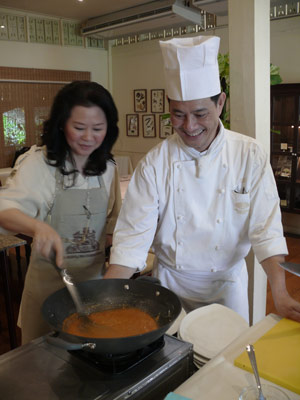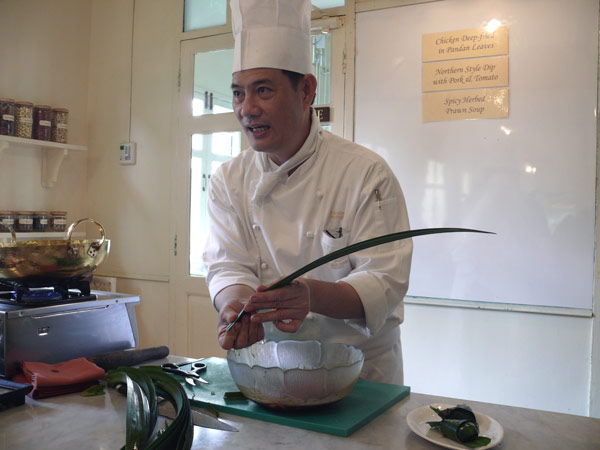BANGKOK – While we wait for our lessons to begin at the Mandarin Oriental Bangkok Hotel’s world renowned Thai Cooking School, members of the class introduce themselves to each other.
“Hello, I’m Fayed from Dubai.”
“Hi, my name is Meg and I’m from California.”
“Good day, I’m Charles — from London.”
“Sawadee ka (hello), I am Yanida and I live in Bangkok all my life.”
The tourists are puzzled. Why is someone who has grown up around Thai cooking taking a course which is meant to enlighten foreigners on the complexities of Thai food preparation?
“Technique — I want to learn technique,” says the sweet talking woman who asks her classmates to call her by her nickname, Wan.
“Thai cooking is art and traditional dishes are very hard to make — even for Thai people,” says the lovely Wan, who has signed up for a week-long course because “I want to learn as much as I can about how to prepare Thai food the proper way.”
She’s come to the right place.
The Oriental, which is globally recognized as the No. 1 hotel on the planet with the world’s top spa, offers what most gastronomy experts agree are the best courses on how to prepare delicate Thai dishes — the most appealing of all Asian cuisine but the hardest to create.
And don’t think the Oriental opened its Thai Cooking School 15 years ago just to entertain tourists. The magnificent hotel, which celebrates its 135th anniversary in 2011, is committed to educating its guests about Thai culture, and food is as important in this country’s rich history as temples and silk.
“We Thais are real foodies,” laughs Wan as our instructor, Chef Narain Kiattiyotcharoen enters the room.
“Thank you all so much for coming here to learn about our food traditions,” says the man whose charm and sense of humour make him a candidate for his own celebrity chef TV show.


Above: Chef Narain makes the cooking lessons fun and educational.
“During our time together I will teach you about the tastes, ingredients and cooking methods that make Thai dishes so unique among Asian cuisine,” says Chef Narain, who dropped out of teaching four years ago to pursue his life-long dream of becoming a chef, which he accomplished after completing the Oriental’s rigorous apprenticeship program.
Over its history, the Oriental’s cooking school has tutored thousands of people in the art of Thai cooking with its hands-on courses, and many tourists re-enroll each time they visit Bangkok.
“I have students who come back every year to learn more about Thai cuisine,” says Chef, who tells the class he’ll show us how to make traditional favourites like Tom Yam Goong (spicy herbed prawn soup), bua loy (sticky rice dumplings in coconut sauce — a dessert), choochee plaa (fried sea bass with curried sauce), naam phrik awng (northern style dip with pork and tomato), gai haw bai toei (chicken deep-fried in pandan leaves) and yam makhuea yao (long green eggplant salad).
Chef stresses to his attentive students that the most important ingredient in Thai cooking is “freshness.”
“We are very fortunate to live in a country where we can get most ingredients by just going out to our gardens where we find fresh limes, coconuts, chilies, herbs, spices, lemongrass — everything that enhances the taste and richness of Thai food.”
Chef says the hardest part of for foreign students is correctly pronouncing the Thai words which describe the ingredients used in class. Real tongue twisters like mamuang sook (mango), glauy (banana), naam mun thua lueng (soybean oil), naam plaa (fish sauce), maprow (coconut), prik thai dum (black pepper), raak phak chee (coriander root), takrai (lemongrass) and makhua yao (long green eggplant.
Chef makes each of the dishes in front of his students and then invites the class to break up into smaller groups where we try to duplicate the master’s creations. After each session, Chef joins his students for lunch and samples the dishes.
Kiattiyotcharoen spices the lessons with some amusing anecdotes about Thai cooking — like the saucy story about how grinding red chilies in a mortar can lead to the perfect marriage.
“When mothers are looking for a potential wife for their son, they’ll spy on the neighbours to see at what pace the neighbour’s daughter is grinding the chilies. A slow pace means she will not make a very good wife but those who grind fast and hard are immediately made a candidate,” laughs Chef.
Thai cooking requires specific ingredients and some members of the class wonder how easy they’ll be to obtain once we get back home. Items like the ginger-like “galangal” or “kaffir lime”, the pimply-faced member of the lime family, for instance.
“All major cities have Asian grocery stores and most carry the items we’ll be using in this course,” says Chef, who’s even found Thai ingredients on his visits to London.
Chef shows the class how to cut lemongrass, a widely used item in Thai cuisine, and says: “you use only the part that is purple — once you stop seeing purple when cutting; you stop and discard the rest.”
This leads to another story.
“Some Japanese students were very annoyed when I told them to discard most of the lemongrass stock (the purple part is located at the bottom of the aromatic herb). They told me they could never do that because lemongrass is so expensive in their country, so they have to use it all.”
While making the fried sea bass and curried sauce dish (choochee plaa), Chef holds up a kaffir lime and says that while it may look unappealing, and its meat is actually too bitter to eat, its pimply skin offers up a divine aromatic scent which richly enhances Thai dishes.
“We don’t waste the rest of the kaffir lime, though,” says Chef. “We cut it into slices and wash our hands with it — it makes a very good soap.”
Limes are used instead of lemons in Thailand because “lemons must be imported and cost a lot of money.”
Coconuts are also a staple in Thai cooking but Chef tells the class that only the milk from young coconuts — no older than three months — is used in dishes because after three months, “Thai people find the milk too bitter.”
One of the most appealing aspects of Thai cooking is food presentation. The artistic Thais, who perfected food carving centuries ago, adorn their tables with fruits that have been turned into beautiful flowers. The delicate technique is still taught in schools throughout Thailand in special classes.
But Chef says there isn’t time to teach us “because it takes years to learn food carving.
“Food carving is very intense – you’ll have to stay here many years to learn that part,” says Chef, who talks proudly about the apprenticeship program the hotel still runs for aspiring young chefs.
As the class ends, Chef invites us to wash up in his outdoor herb garden using the kaffir lime “soap” and then begins to sample the dishes we’ve made.
We’re on the edge of our seats as he bites into the fried sea bass, slurps up the spicy prawn soup and samples the rest of the dishes.
“Hmmmm,” begins Chef. “I wish I could cook like this.
“Your cooking skills earn my highest marks,” says the charming Chef who produces certificates indicating we’ve graduated with flying food colours.
The Oriental’s Thai Cooking School gives guests some food for thought when visiting the hotel and those who take it agree it’s a sweet treat.